Introduction
Starting your journey in building muscle can feel overwhelming, but with the right approach, anyone can achieve strong, sustainable results. Strength training is the most effective way to stimulate muscle growth, improve strength, and boost metabolism. For beginners, the key is to focus on proper form, progressive overload, and consistency.
Before diving into heavy weights, master the basics. Compound exercises like squats, deadlifts, bench presses, and pull-ups engage multiple muscle groups, maximizing efficiency. Begin with lighter weights to perfect your technique and prevent injuries. Aim for 3-4 strength training sessions per week, allowing muscles time to recover and grow.
Nutrition plays a crucial role in building muscle. Consume enough protein (0.7-1g per pound of body weight) to support muscle repair, along with a balanced diet of carbs and healthy fats for energy. Staying hydrated and getting adequate sleep (7-9 hours per night) further enhances recovery.
Progressive overload—gradually increasing weight or reps—ensures continuous muscle growth. Track your workouts to monitor progress and stay motivated.
Whether your goal is increased strength, better physique, or improved health, building muscle through strength training is a rewarding process. Start slow, stay consistent, and watch your body transform!
Ready to begin? Follow these steps, and you’ll be on your way to a stronger, more muscular you!
Why Strength Training is Crucial for Women
While building visible muscle is a fantastic outcome, Strength Training Exercises offer women a wealth of crucial benefits that extend far beyond aesthetics. Understanding these advantages can be a powerful motivator to incorporate regular resistance training into your life.
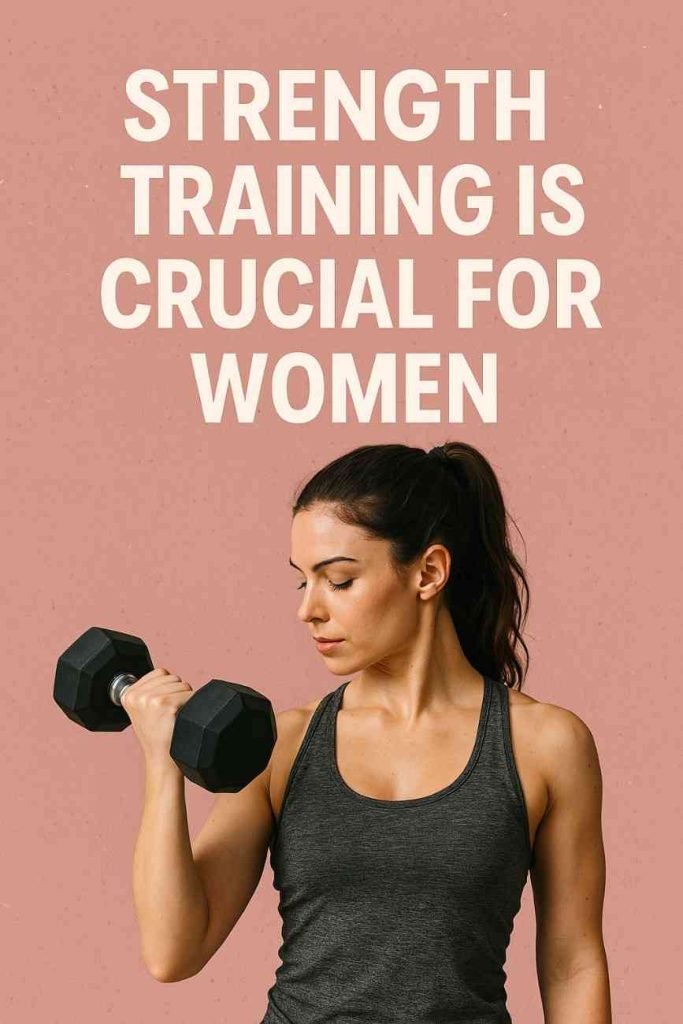
Here’s why strength training is so vital for women:
Increased Metabolism and Fat Loss:
Muscle tissue burns more calories at rest than fat tissue. By engaging in Strength Training Exercises and increasing your muscle mass, you effectively boost your resting metabolic rate. This means your body burns more calories throughout the day, even when you’re not actively working out, aiding significantly in sustainable fat loss and weight management.
Improved Bone Density (Combating Osteoporosis):
Women are at a higher risk of developing osteoporosis, a condition characterized by weak and brittle bones, particularly after menopause. Strength Training Exercises place beneficial stress on your bones, signaling bone-building cells to spring into action. This process increases bone mineral density, making your skeleton stronger and more resilient against fractures.
Enhanced Mood and Confidence:
The benefits of Strength Training Exercises aren’t just physical. Regular workouts trigger the release of endorphins, natural mood lifters that can help alleviate stress, anxiety, and symptoms of depression. Moreover, achieving new strength goals and witnessing your body become more capable can profoundly boost self-esteem and overall confidence.
Better Functional Strength for Daily Activities:
Strength Training Exercises build strength that translates directly into everyday life. Carrying groceries, lifting children, moving furniture, or even just climbing stairs becomes easier and less taxing. This improved functional strength enhances your independence and quality of life, allowing you to perform daily tasks with greater ease and reduced risk of strain.
Reduced Risk of Injury:
Strong muscles act as crucial support for your joints and connective tissues. Strength Training Exercises help improve balance, coordination, and stability, which can significantly reduce the risk of falls and injuries in both athletic pursuits and everyday activities. Stronger core muscles, in particular, contribute to better posture and can alleviate back pain.
Hormonal Balance Benefits:
Strength Training Exercises can positively influence hormonal balance in women. It can help regulate levels of hormones like insulin, improving insulin sensitivity and potentially reducing the risk of type 2 diabetes. Additionally, it can play a role in managing cortisol (the stress hormone) levels and supporting overall endocrine health, which is crucial for various bodily functions, including mood, sleep, and reproductive health.
Incorporating Strength Training Exercises is an investment in your long-term health, vitality, and well-being, empowering you from the inside out.
The 7 Best Strength Training Exercises for Women
1. Squats – The Ultimate Lower Body Strength Builder
Why? Squats are one of the best strength training exercises for women, engaging the quads, glutes, hamstrings, and core in a single powerful movement. They promote muscle growth, improve mobility, and enhance functional strength for daily activities.
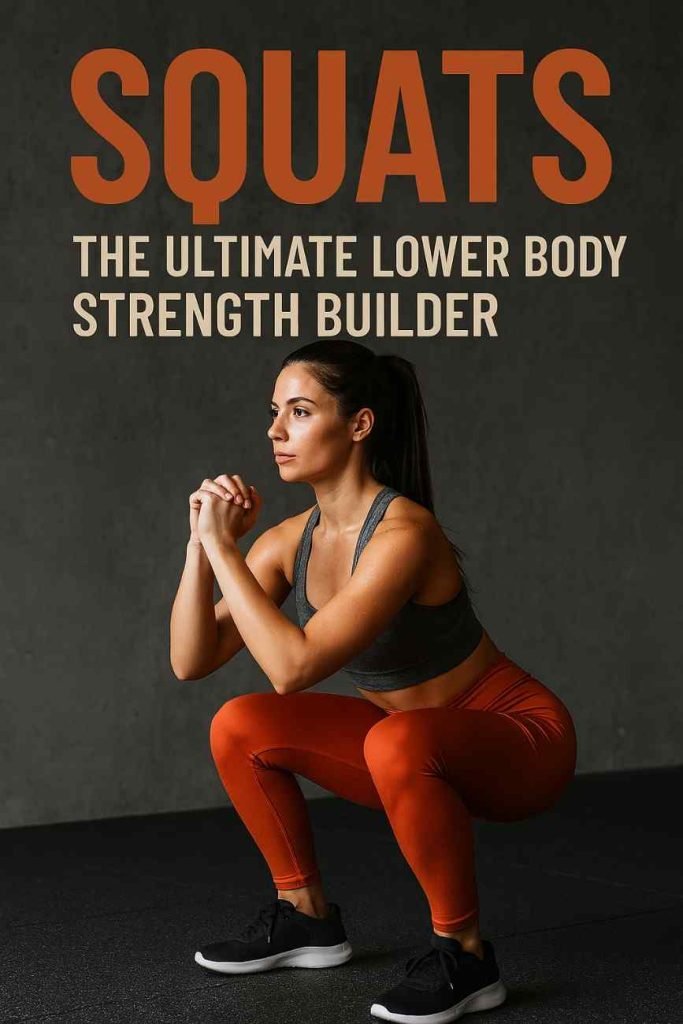
Variations to Try:
- Goblet Squats (Great for beginners)
- Barbell Back Squats (Ideal for progressive overload)
- Bulgarian Split Squats (Unilateral strength & balance)
Proper Form Tips:
✔ Keep your chest up – Avoid leaning forward.
✔ Knees in line with toes – Prevents inward collapse.
✔ Control your depth – Aim for thighs parallel to the floor (or deeper if mobility allows).
✔ Engage your core – Protects your lower back.
Bonus: Squats also boost metabolism by activating large muscle groups, helping with fat loss while building a stronger, more defined lower body.
2. Deadlifts – The Ultimate Posterior Chain Powerhouse
Why? Deadlifts rank among the most effective strength training exercises for women, activating the entire posterior chain—glutes, hamstrings, and back—while also engaging the core and grip strength. This compound lift builds functional strength, improves posture, and enhances athletic performance.
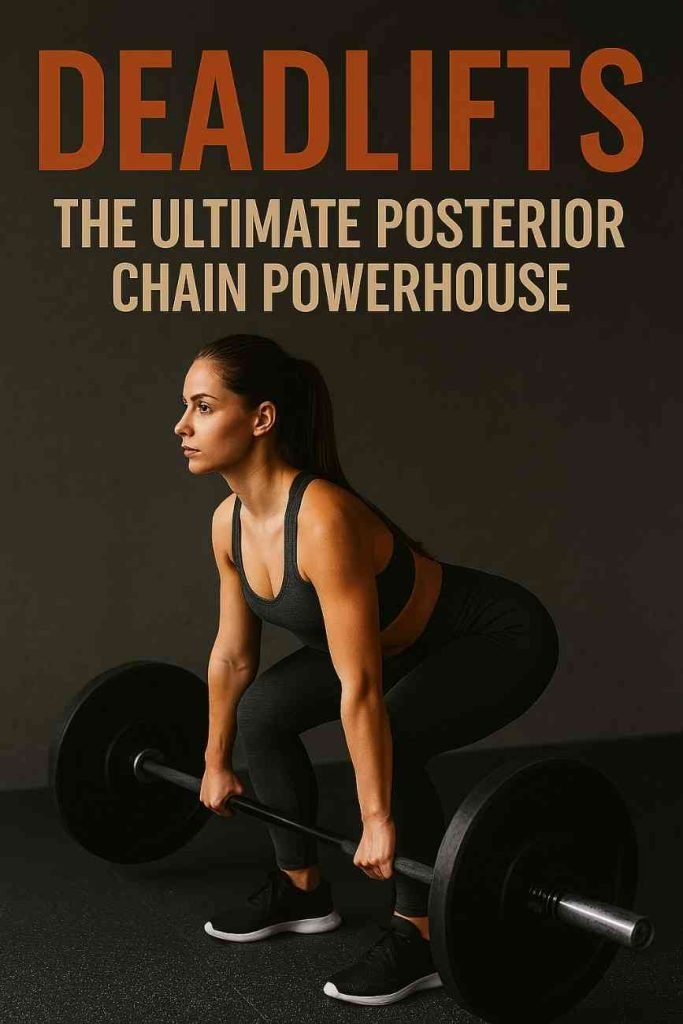
Key Benefits for Women:
✔ Glute & Hamstring Development – Shapes strong, defined legs
✔ Spinal & Core Stability – Reduces back pain risk
✔ Hormonal Response – Stimulates muscle-building hormones
✔ Real-World Strength – Makes lifting groceries, kids, or luggage easier
Deadlift Variations to Master:
- Romanian Deadlifts (RDLs) – Focuses on hamstring and glute stretch
- Sumo Deadlifts – Wider stance reduces lower back strain
- Trap Bar Deadlifts – Beginner-friendly with natural weight distribution
Perfect Your Form:
✔ Brace Your Core – Like you’re about to take a punch
✔ Flat Back Always – No rounding! Hinge at hips, not waist
✔ Heel Drive – Push through heels to activate glutes
✔ Bar Close to Body – Scrapes your shins/thighs on the way up
Pro Tip: Start light to nail the hip hinge motion before adding weight. Many women see rapid progress with deadlifts!
3. Hip Thrusts – The Gold Standard for Glute Growth
Why? Hip thrusts are the most effective strength training exercise for glute development, outperforming squats and deadlifts for direct glute activation. This movement specifically targets the gluteus maximus, medius, and minimus, helping women build a stronger, rounder backside while improving hip stability and athletic performance.
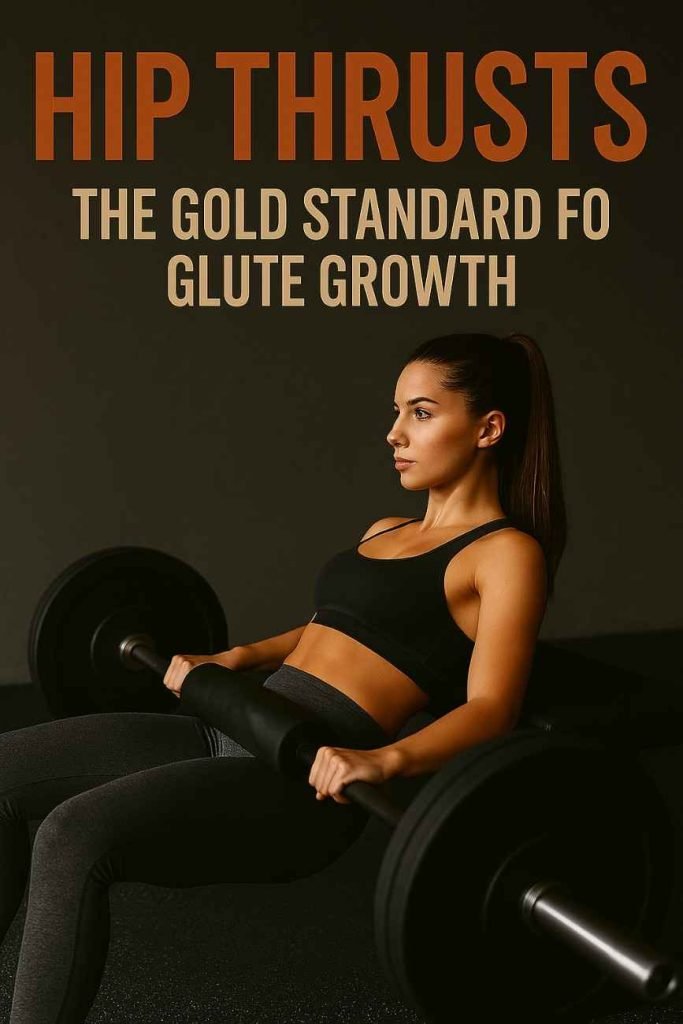
Science-Backed Benefits:
Superior Glute Activation – Studies show 2X more EMG activity than squats
Improved Athletic Performance – Enhances sprinting and jumping power
Injury Prevention – Strengthens hips to reduce knee and back pain
Posture Correction – Counteracts the effects of prolonged sitting
Game-Changing Variations:
- Banded Hip Thrusts – Adds constant tension throughout movement
- Single-Leg Hip Thrusts – Corrects muscle imbalances
- Barbell Hip Thrusts – Best for progressive overload
Flawless Execution:
✔ Drive Through Your Heels – Maximizes glute engagement
✔ Squeeze at the Top – Hold for 1-2 seconds for peak contraction
✔ Neutral Spine – Avoid excessive arching to protect lower back
✔ Adjust Bench Height – Shoulder blades on bench, knees at 90°
Pro Tip: For mind-muscle connection, place fingers on glutes to ensure they’re firing. Many women see noticeable growth within 4-6 weeks of consistent hip thrusting!
4. Bench Press & Push-Ups – Upper Body Strength Essentials
Why? The bench press (and its bodyweight counterpart, push-ups) are fundamental strength training exercises for women that develop chest, shoulders, and triceps while improving pushing power and upper-body aesthetics. Contrary to myths, these movements won’t “bulk” women up but instead create toned arms, improved posture, and functional strength for daily movements.
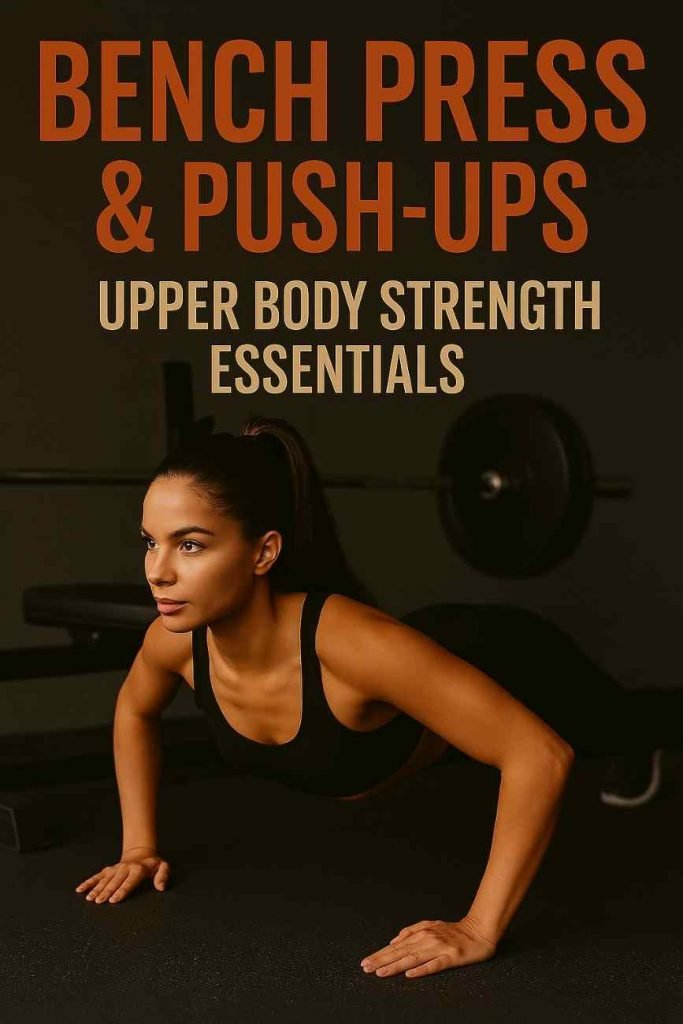
Key Benefits for Women:
Balanced Physique – Counters excessive lower body focus
Metabolic Boost – Engages multiple upper body muscles
Shoulder Stability – Reduces injury risk in other lifts
Real-World Application – Makes pushing motions (doors, strollers) effortless
Progressions for All Levels:
- Beginner: Kneeling Push-Ups → Standard Push-Ups
- Intermediate: Dumbbell Bench Press → Barbell Bench Press
- Advanced: Incline Bench Press → Weighted Push-Ups
Perfect Your Press:
✔ Shoulder Blades Pinched – Creates a stable base
✔ Controlled Tempo – 2 seconds down, 1 second pause, explosive up
✔ Full Range of Motion – Bar lightly touches chest (bench) or chest to floor (push-ups)
✔ Elbow Position – 45° angle to protect shoulders
Pro Tip: Women often excel at higher rep ranges (8-15) for upper body growth due to muscle fiber distribution.
5. Pull-Ups & Lat Pulldowns – The Ultimate Back Builders
Why? Pull-ups (and lat pulldowns) are essential strength training exercises for women that develop a strong, sculpted back, improve posture, and create balanced upper-body strength. These movements primarily target the lats, biceps, and core, helping to counteract rounded shoulders from sitting and build a powerful, V-tapered physique.
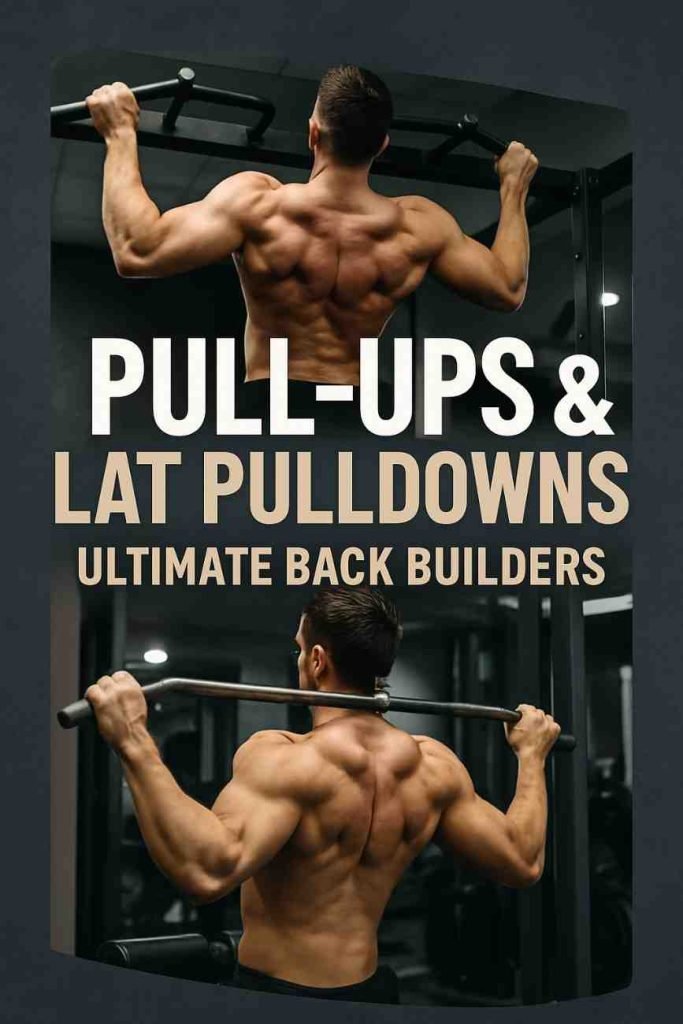
Key Benefits for Women:
Posture Perfection – Counters “tech neck” and slouching
Functional Strength – Makes lifting, pulling, and carrying easier
Metabolic Burn – Engages multiple large muscle groups
Aesthetic Bonus – Creates that coveted “toned back” look in dresses and tops
Smart Variations for All Levels:
- Beginner: Band-Assisted Pull-Ups → Lat Pulldowns
- Intermediate: Inverted Rows → Negative Pull-Ups
- Advanced: Weighted Pull-Ups → Archer Pull-Ups
Master the Movement:
✔ Engage Lats First – Imagine squeezing a pencil between shoulder blades
✔ Full Range of Motion – Start from dead hang, chin over bar
✔ Avoid Kipping – Control the movement without swinging
✔ Progressive Overload – Add resistance bands or weight as you improve
Pro Tip: Many women see fastest progress with greasing the groove – doing multiple submaximal sets throughout the day rather than one exhausting session.
6. Overhead Press – Shoulder Strength & Definition
Why? The overhead press is one of the most effective strength training exercises for women to build strong, sculpted shoulders and triceps while enhancing upper-body stability. This compound movement targets the deltoids, triceps, and core, helping to create balanced upper-body strength and improve functional pressing power.
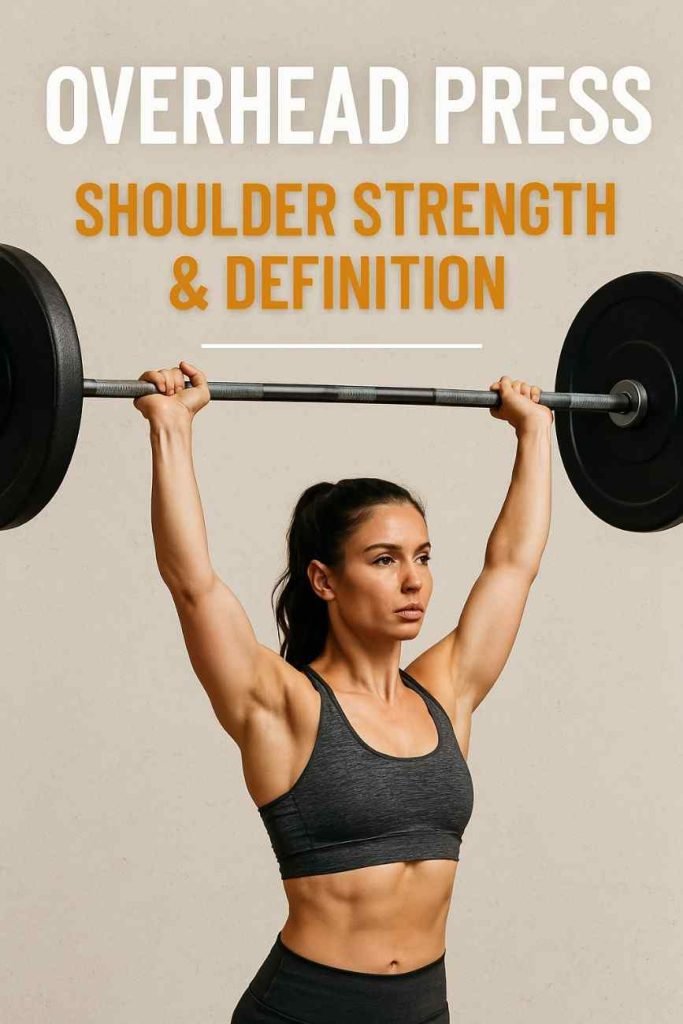
Key Benefits for Women:
Toned Shoulders – Enhances the “cap” look for sleeveless tops
Core Engagement – Builds anti-extension strength for better posture
Functional Fitness – Makes lifting objects overhead easier and safer
Joint Health – Strengthens shoulder stabilizers to prevent injuries
Variations for All Levels:
- Dumbbell Shoulder Press – Allows natural arm path
- Arnold Press – Increases range of motion for full delt activation
- Seated Overhead Press – Reduces lower back strain
Perfect Your Press:
✔ Brace Your Core – Prevent excessive back arching
✔ Press Straight Up – Bar path should be vertical, not forward
✔ Full Range of Motion – Lower until elbows are at 90°
✔ Wrist Alignment – Keep wrists straight, not bent back
Pro Tip: Women often benefit from higher rep ranges (8-12) for shoulder development due to greater Type I muscle fibers in the deltoids.
7. Lunges – The Unilateral Strength Master
Why? Lunges are essential strength training exercises for women that build balanced, functional lower-body strength by working each leg independently. This unilateral movement targets quads, glutes, hamstrings, and core, correcting muscle imbalances while improving stability and coordination.
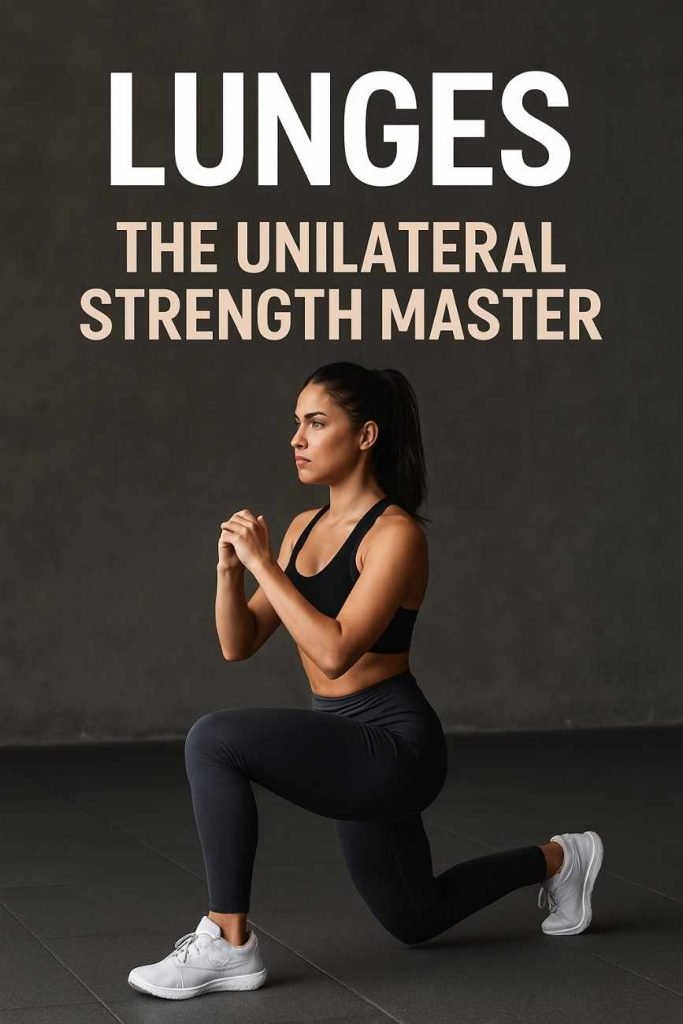
Key Benefits for Women:
Fixes Muscle Imbalances – Prevents dominant-side overuse
Functional Fitness – Mimics real-world movements like stair climbing
Joint-Friendly – Less spinal load than heavy squats
Aesthetic Perks – Sculpts lean, symmetrical legs
Smart Variations:
- Reverse Lunges – Easier on knees (ideal for beginners)
- Walking Lunges – Adds dynamic core challenge
- Weighted Lunges – Dumbbells or kettlebells for progression
Perfect Your Lunge:
✔ Upright Torso – Imagine a string pulling your head up
✔ 90° Knee Angles – Front knee behind toes, back knee hovering
✔ Controlled Descent – 2 seconds down, explosive up
✔ Step Far Enough – Prevents excessive forward knee travel
Pro Tip: For glute emphasis, take a slightly longer step. For quad focus, use a shorter stride.
Your Complete Strength Training Blueprint
Now that you’ve discovered these 7 essential strength training exercises for women, here’s how to combine them:
Sample Workout Structure:
- Lower Body Focus: Squats + Deadlifts + Lunges
- Upper Body Focus: Bench Press + Pull-Ups + Overhead Press
- Glute Specialization: Hip Thrusts + Reverse Lunges
Progression Strategy:
- Master bodyweight form
- Add resistance (bands → dumbbells → barbells)
- Increase weight gradually (5-10% weekly)
Remember: Consistency + Progressive Overload = Transformational Results!
Nutrition Tips to Maximize Your Strength Training Results
Proper nutrition is just as important as your workout routine when it comes to building muscle, boosting strength, and recovering effectively. Whether you’re doing squats, deadlifts, hip thrusts, or pull-ups, fueling your body correctly will help you see faster progress and feel stronger in every session.
Here’s your science-backed nutrition guide for women doing strength training exercises:
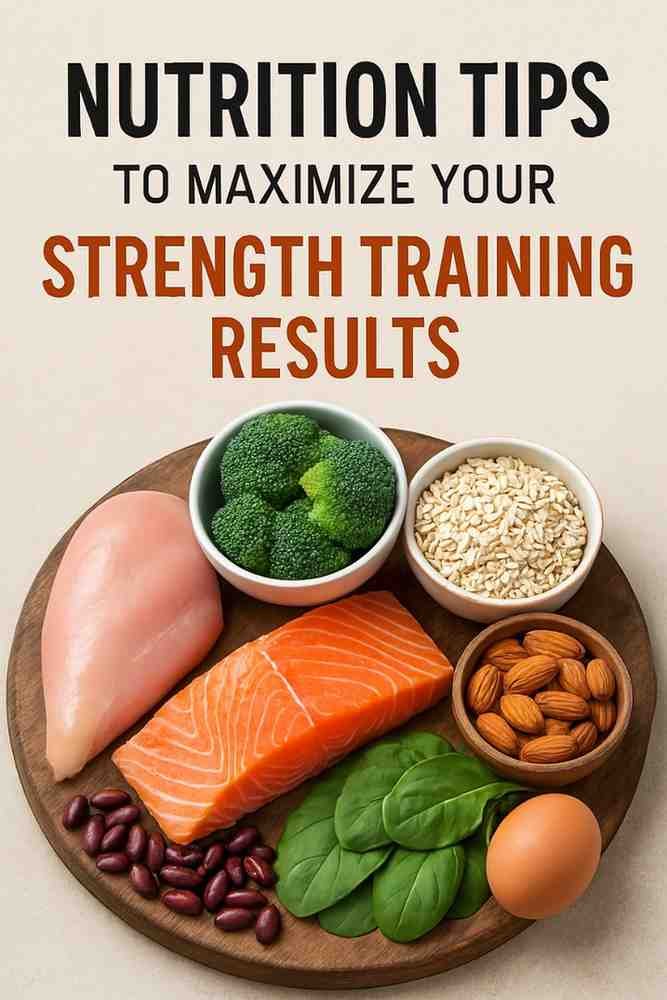
1. Prioritize Protein for Muscle Growth & Repair
Why? Protein provides the building blocks (amino acids) needed to repair and grow muscle after strength training.
✅ Best Sources:
- Lean meats (chicken, turkey, lean beef)
- Fish (salmon, tuna, cod)
- Eggs & dairy (Greek yogurt, cottage cheese)
- Plant-based (tofu, tempeh, lentils, chickpeas)
How Much?
- 1.6–2.2g of protein per kg of body weight (e.g., 70 g+ for a 140lb woman)
- Spread intake evenly (20–30g per meal)
2. Don’t Fear Carbs – They Fuel Your Workouts
Why? Carbs replenish glycogen (muscle energy) and help you push harder in the gym.
✅ Best Sources:
- Whole grains (oats, quinoa, brown rice)
- Fruits (bananas, berries, apples)
- Starchy veggies (sweet potatoes, squash)
When to Eat Them?
- Pre-workout: Slow-digesting carbs (oatmeal, whole-grain toast)
- Post-workout: Fast-digesting carbs (white rice, fruit)
3. Healthy Fats Support Hormones & Recovery
Why? Fats help regulate hormones (like estrogen and testosterone), which are crucial for muscle growth.
✅ Best Sources:
- Avocados, nuts & seeds
- Olive oil, coconut oil
- Fatty fish (salmon, mackerel)
How Much?
- 20–30% of daily calories
4. Hydration = Strength & Endurance
Why? Even 2% dehydration can reduce strength and performance.
Hydration Tips:
- Drink ½–1 oz of water per pound of body weight daily
- Add electrolytes (sodium, potassium) if training intensely
5. Timing Matters – Pre & Post-Workout Nutrition
Pre-Workout (1–2 Hours Before):
- Protein + Carbs (e.g., Greek yogurt + banana)
- Avoid heavy fats/fiber (slows digestion)
Post-Workout (Within 30–60 Min):
- Protein + Fast Carbs (e.g., protein shake + white rice)
- Helps muscle repair and glycogen reload
6. Supplements That Help (But Aren’t Mandatory)
- Whey Protein – Convenient post-workout option
- Creatine – Boosts strength & muscle growth (5g/day)
- Omega-3s – Reduces inflammation
7. Avoid These Common Mistakes
Skipping meals → Slows recovery
Eating too little → Limits muscle growth
Overdoing processed foods → Causes energy crashes
Beginner-Friendly Weekly Strength Training Routine for Women
This balanced 3-day plan incorporates the 7 best strength training exercises while allowing for proper recovery. Perfect for women new to lifting or returning after a break!
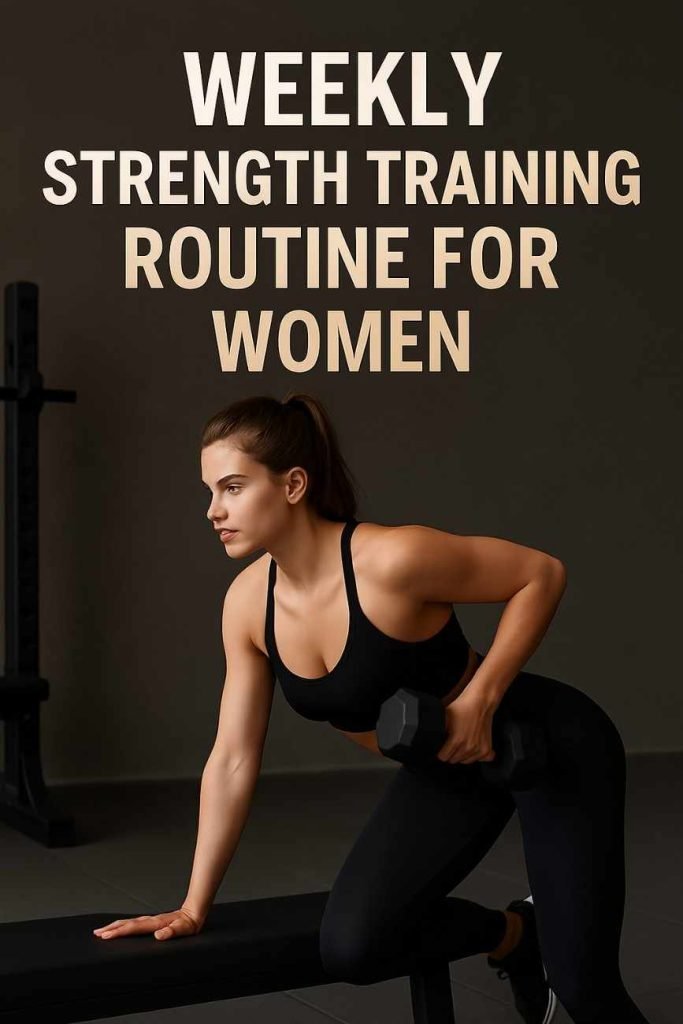
Workout Split:
✅ Day 1: Lower Body Focus
✅ Day 2: Upper Body Focus
✅ Day 3: Full Body + Glutes
(Rest or active recovery between sessions)
Day 1: Lower Body Strength
1. Goblet Squats – 3 sets x 8-10 reps
2. Romanian Deadlifts – 3 sets x 8 reps
3. Reverse Lunges – 2 sets x 10 reps/side
4. Plank – 3 sets x 20-30 sec
Focus: Master form before adding weight
Day 2: Upper Body Strength
1. Push-Ups (Kneeling if needed) – 3 sets x 6-10 reps
2. Lat Pulldowns – 3 sets x 10 reps
3. Dumbbell Shoulder Press – 3 sets x 8 reps
4. Banded Face Pulls – 2 sets x 12 reps
Tip: Go lighter to perfect technique
Day 3: Full Body + Glutes
1. Hip Thrusts – 3 sets x 10 reps
2. Dumbbell Bench Press – 3 sets x 8 reps
3. Bodyweight Rows – 3 sets x 8 reps
4. Farmer’s Carry – 2 sets x 30 sec
Bonus: Adds functional core work
Key Guidelines for Beginners:
Rest Time: 60-90 sec between sets
Progression: Add 2.5-5 lbs weekly
Form First! Film yourself or ask a trainer for feedback
Active Recovery: Walk, swim, or do yoga on off days
Sample Weekly Schedule:
| Monday | Tuesday | Wednesday | Thursday | Friday | Weekend |
|---|---|---|---|---|---|
| Lower Body | Active Rest | Upper Body | Active Rest | Full Body | Rest/Yoga |
Why This Works for Beginners:
Balanced Approach – Hits all major muscle groups
Manageable Volume – Prevents burnout
Foundation Building – Prepares you for advanced routines
Stick with this for 4-6 weeks before increasing intensity!
Want the intermediate version after mastering this? Let me know!
Conclusion
Incorporating Strength Training Exercises into your fitness regimen is a transformative step for any woman seeking to build muscle, enhance her physical capabilities, and boost her overall well-being. As we’ve explored, the benefits extend far beyond aesthetics, playing a crucial role in increasing metabolism for effective fat loss, fortifying bone density to combat osteoporosis, elevating mood and confidence, improving functional strength for everyday tasks, reducing injury risk, and even supporting hormonal balance.
The exercises highlighted, starting with foundational movements like squats and their variations, provide a solid starting point to target major muscle groups effectively. Remember, consistency is key. Aim to progressively challenge yourself, whether by increasing weight, reps, or refining your technique.
Listen to your body, prioritize proper form to prevent injuries, and complement your training with adequate nutrition and rest to optimize muscle growth and recovery. Embarking on a strength training journey is an empowering investment in your long-term health and vitality. Embrace the process, celebrate your progress, and unlock a stronger, more resilient you.
